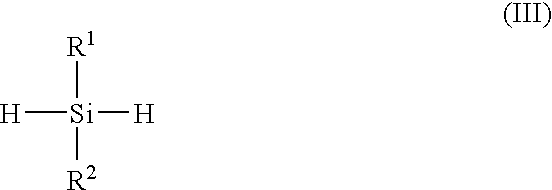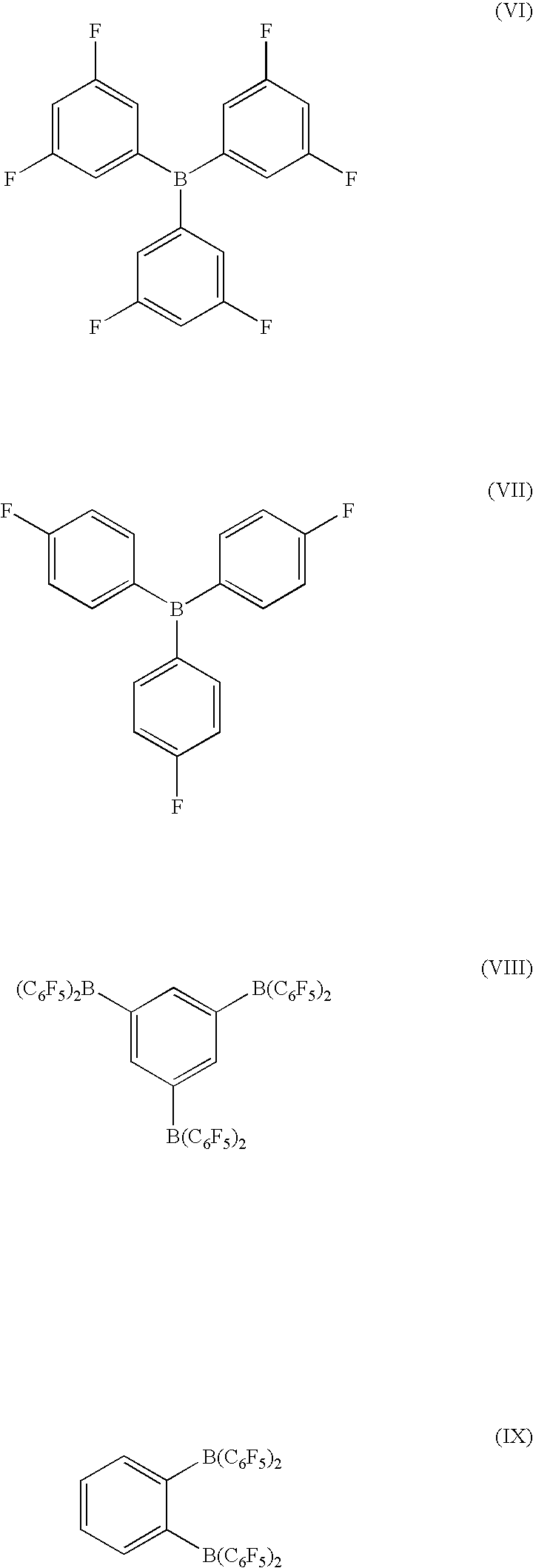Process for synthesis of diorganosilanes by disproportionation of hydridosiloxanes
- Summary
- Abstract
- Description
- Claims
- Application Information
AI Technical Summary
Benefits of technology
Problems solved by technology
Method used
Image
Examples
example 1
Oligomerization of 1,1,3,3-tetramethyldisiloxane
[0035]In a reaction flask, 0.755 grams (g) (5.62 mmoles) of 1,1,3,3-tetramethyldisiloxane and pre-purified toluene were added using a high vacuum line. Then the flask was filled with dry nitrogen and 0.225 g of dodecane (internal standard for GC analysis) and 0.0124 g (0.024 mmoles) of the catalyst (B(C6F5)3) were added using a precision Hamilton syringe under a flow of dry nitrogen. At this point vigorous evolution of gas was observed. Samples were withdrawn at timed intervals, quenched with an excess of 3-ethylpyridine and analyzed by gas chromatography. The assignment of signals was performed by the GC-MS analysis using chemical ionization technique. GC-MS analysis showed that the main products of the reaction were Me2SiH2, oligomers of the general formula HMe2Si(OSiMe2)nOSiMe2H where n=1,2,3 . . . and cyclic siloxanes of series (Me2SiO)n where n=3,4 and 5.
[0036]Reaction progress, monitored by following the decrease of the substrate...
example 2
Reactions of 1,1,3,3,5,5,7,7-octamethyltetrasiloxane
[0037]In a reaction flask, 0.980 grams (g) (4.10 mmoles) of 1,1,3,3,5,5,7,7-octamethyltetrasiloxane and pre-purified toluene were added using a high vacuum line. Then the flask was filled with dry nitrogen and 0.225 g of dodecane (internal standard for GC analysis) and 0.0303 g (0.06 mmoles) of the catalyst (B(C6F5)3) were added using a precision Hamilton syringe under a flow of dry nitrogen. At this point vigorous evolution of gas was observed. Samples were withdrawn at timed intervals, quenched with an excess of 3-ethylpyridine and analyzed by gas chromatography. The assignment of signals was performed by the GC-MS analysis using chemical ionization technique. GC-MS analysis showed that the main products of the reaction were Me2SiH2 and hexamethylcyclotrisiloxane, D3.
[0038]Reaction progress, monitored by following the decrease of the substrate concentration showed a fast conversion of the substrate initially (57% decrease in less...
PUM
 Login to View More
Login to View More Abstract
Description
Claims
Application Information
 Login to View More
Login to View More - R&D
- Intellectual Property
- Life Sciences
- Materials
- Tech Scout
- Unparalleled Data Quality
- Higher Quality Content
- 60% Fewer Hallucinations
Browse by: Latest US Patents, China's latest patents, Technical Efficacy Thesaurus, Application Domain, Technology Topic, Popular Technical Reports.
© 2025 PatSnap. All rights reserved.Legal|Privacy policy|Modern Slavery Act Transparency Statement|Sitemap|About US| Contact US: help@patsnap.com



